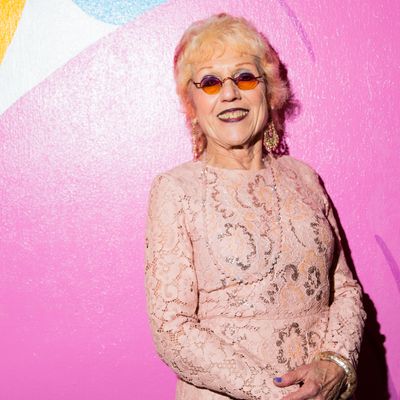
At Art Basel in Miami Beach, those looking at and buying the art are often just as colorful as the work itself. With her bright pink hair, dark lipstick, and matching tinted glasses, which she wears indoors, Judy Chicago was arguably one of the most colorful characters at the fair this year.
The pioneering feminist artist was in town to celebrate the opening of her new show, Judy Chicago: A Reckoning, at the Institute of Contemporary Art (ICA). As she will tell you, it is not a “retrospective” but rather a “survey” of her work, starting in the 1960s. Many of the subjects she represents — men driving the world into flames, for example — feel eerily relevant today.
The show is sponsored by MaxMara and comes with its own merch. It serves as a reminder that Chicago is much more than the artist who painted The Dinner Party, her most famous work. Below, a candid conversation with the artist just days after her opening at the ICA.
How has your Art Basel experience been so far?
I haven’t even been to the fair. At the ICA opening, we arrived at 6:20 and left at 7:40, and in that period of time all I did was stand there and have my picture taken. Press photos, fan photos, selfies …. People kept coming up to me and asking, “Are you having fun?” And no one seemed to think this was funny except for me. I said, “Yeah, my lifelong goal as an artist was to become a model.”
How does that make you feel, to have people come up to you like that in public?
It means a lot when people, especially young people, come up to me and tell me how much my work has meant to them. That never stops being touching and moving. After all, what’s art for? But it’s a mixed bag. I understand that they’d really like to feel like they had a connection with me.
It didn’t happen unless there’s a picture.
Right, our conversation doesn’t count!
Well, I saw the ICA show yesterday and I was so happy I did. I live across the street from The Dinner Party at the Brooklyn Museum, but I hadn’t interacted with a lot of your other works before.
You and a lot of other people. For the longest time, you’d mention my name and all people would think of was The Dinner Party. So, I’m happy people are seeing my other work, too. Some people say it’s a retrospective, but it’s not. It’s a three-decade survey.
I’ve been reading Rebecca Traister’s book, Good and Mad, and I thought about it a lot while walking around your show.
Oh yes, about how women aren’t allowed to be angry. I know all about that. The other day at the opening, the daughter of a collector came up to me and said, “I really like your stuff.” And I said, “You suppose you could find another word?” And she got all upset, like she was criticized. I mean, I thought it was a joke, and it’s not the right word. But even a mild rebuke seems to be impermissible.
I thought about female anger in relation to your work, but also how change happens really slowly. You have one painting of a man driving the world to destruction, for example.
Yes, which I painted in 1985. Your generation is all, “Click, click, change the shape!” And that’s how you think change happens. But it doesn’t.
What would you tell a 20-something like myself about change?
About your impatience for change? Well, I’ve lived my whole life impatient for change. My work is about making a contribution to change. And change happens very slowly. But what has given my life meaning is working towards it, and not giving up.
And what would you tell a young artist, specifically, about the art world?If a young woman wants to be an artist — if she really wants to know the truth about what she’s going to encounter — she should study my career. Because my career is a roadmap that outlines the difficulties. It’s important to know what you’re going to face, and to be able to identify it. I’ve seen a lot of women along the way who’ve thought it was something wrong with them when they faced discrimination, obstacles, rejection, etc. That’s been unfortunate. One woman came to an event this week and told me a story that I’ve heard a million times. She was in art school in the ‘90s and she was inspired by my work, and I guess it showed. She had all-male professors, and they said, “Who are you trying to be? Judy Chicago?” They said, “Feminism is passé.” And I said to her, “Yeah, but patriarchy is not.” If she had been influenced by Jeff Koons, they never would have said that.
I would also say that the way I was able to overcome the many, many obstacles that I encountered was by knowing the stories of the women before me. When I read about Elizabeth Blackwell, who was the first woman to be allowed into medical school in America, I thought, If she can do it, I can do it. We have a whole lot of information to help us, but the problem is that the institutions are not doing their job by not passing it on.
Speaking of Jeff Koons, I see that you’re getting a lot of questions about corporate feminism, and partnering with a fashion brand like MaxMara on T-shirts. I don’t think anyone asked him about selling out when he partnered with Louis Vuitton.
Finally, I came up with an answer. I said: “Well, I’d rather market feminism than the patriarchy.” I mean, really, you think about how patriarchal values are marketed through television, advertising, football games — it’s a constant bombardment of advertising masculinity. It’s the landscape, to the point that no one really notices it. But it also shows how hard it is to introduce new ideas into the patriarchal landscape. And when you try, it becomes suspect.
I agree that we have to be careful about articulating that it’s change we’re after, not profit. Change. Do I like it that people are marketing Dinner Party plates with historical information on the back about the woman represented? Yes, I like that. These are the ways change happens: By introducing alternative ideas and images into the culture at a really large level.
You’ve got new “Bigamy Hood” T-shirts, plates, and beach towels.
Aren’t they great? The thing that’s really funny is that the beach towel is so phallic, you cannot believe it. When I first saw it, I was like … Oh! Now every woman can have her own dick. And a man can have two.






